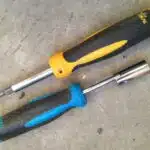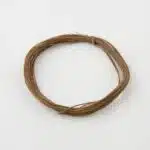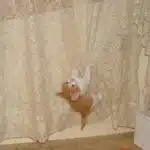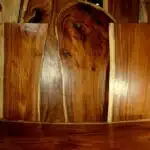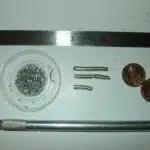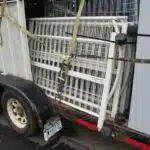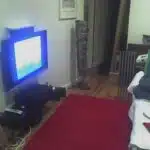As a TV wire management expert, I understand the frustration that comes with unsightly cords and cables cluttering up your living space. Whether it’s for aesthetic purposes or simply to keep cords out of reach of children or pets, hiding TV wires is a task that requires planning and effort. In today’s fast-paced world, homeowners want a solution that is both practical and visually appealing. Fortunately, there are several ways to achieve this goal.
In this article, we will explore different methods to hide TV wires effectively. From simple DIY options to more complex setups, we’ll discuss how to conceal cords behind walls or furniture, use cord covers and raceways, or even incorporate them into decorative elements in your home. Regardless of your preferred method, the key is to find a solution that works for you and your household needs. So let’s dive in and discover how you can make your home more aesthetically pleasing while also keeping it safe and organized.
Assessing Your Tv Setup
Assessing the space where your TV is located is essential to determine the best way to hide your wires. Consider the area’s layout and size, as well as any furniture and decor present. If your TV is mounted on a wall, check for stud placement and ensure it’s at a comfortable viewing height. Identifying potential obstacles such as baseboards, window frames, or doorways will help you plan accordingly.
Take note of any electrical outlets in the vicinity of your TV setup. Depending on their location, you may need to consider running wires through walls or ceilings to reach them. Another factor to consider is the amount and type of equipment you have connected to your TV, such as cable boxes, gaming consoles, or sound systems. These components can add complexity to wire management but can also provide opportunities for creative solutions.
By assessing your TV setup thoroughly, you’ll be better equipped to identify obstacles and create a plan for managing wires that suits both the space and your needs. With careful consideration of these factors, you can achieve a clutter-free setup that enhances both your viewing experience and overall room aesthetics. Next up is planning your wire management strategy – let’s dive into some helpful tips!
Planning Your Wire Management Strategy
To make sure that your TV wires remain hidden, you need to plan your wire management strategy. This involves measuring the space where your TV is located and identifying potential cable management solutions that you can use. Some popular cable management solutions include cord covers, raceways, and in-wall cable systems.
Measuring space is crucial when it comes to wire management because it allows you to determine the length of cables needed to connect your TV components. You should also measure the height of your walls and the distance between power outlets and devices. It’s important to ensure that your cables are long enough to reach all your devices but not so long that they create clutter.
Cable management solutions come in different shapes and sizes, so it’s essential to choose one that fits not only the size of the cables but also the aesthetics of your home. Cord covers work well for hiding wires on floors or walls, while raceways are ideal for concealing wires in tight spaces. In-wall cable systems are a more permanent solution that requires professional installation but provides a sleek look.
By planning ahead and measuring space, you can identify which cable management solution is best suited for your needs. Once you have chosen the right tools and materials, it’s time to move on to the next step of installing them properly for a clean and organized look.
Choosing The Right Tools And Materials
- Before beginning a project to hide TV wires, it is important to assess the area to determine the scope and complexity of the task.
- Having the right tools for the job is essential for success. Common tools used for this task include a measuring tape, screwdriver, drill, and cable management tools.
- Appropriate materials are necessary for a successful installation. Choosing cables of the correct length and type, as well as wall mounts and other hardware, is essential for a secure and aesthetically pleasing result.
- For areas that require flexibility, such as curved walls, special tools may be required to make the correct measurements and cuts.
- When working with electrical outlets, it is important to use the correct type of cable to ensure safety.
- It is also important to consider the material of the walls or other surfaces to ensure the correct type of anchors are used.
Surveying The Room
Are you tired of staring at unsightly TV wires that seem to be taking over your living space? Fear not, as a wire management expert, I am here to provide you with some valuable tips on how to hide those pesky cords. One of the first steps in doing so is surveying the room and analyzing the furniture placement.
Room layout plays a crucial role in managing wires. Before purchasing any materials or tools, it’s important to take note of where your outlets are located and which areas of the room require cable management. Consider the position of your TV and its proximity to power sources and other electronic devices. This will help determine what type of equipment you need to hide those wires effectively.
Furniture placement also plays a significant role in hiding TV wires. Take into account where you have placed your entertainment center or wall-mounted TV stand. If possible, try to place it against a solid-colored wall that provides ample space for concealing cables. Additionally, consider investing in furniture pieces designed specifically for wire management such as media consoles or wall units that come equipped with built-in cord organizers. With these simple steps, you can achieve a sleek and tidy look for your living space while keeping those unruly cords out of sight.
Selecting Adequate Tools
As a wire management expert, I cannot overemphasize the importance of selecting adequate tools when it comes to hiding TV wires. It’s not just about the aesthetics; it’s also about safety and functionality. One of the crucial factors to consider when choosing the right tools is tool compatibility. Not all cable management tools work for every type of wire or installation method, so it’s important to choose the ones that are appropriate for your specific needs.
Another factor to keep in mind is tool budgeting. While there are numerous options available in the market, not all of them have to break the bank. There are many affordable options for those on a tight budget, although they may require more effort and creativity to install and use effectively. On the other hand, more expensive tools may offer additional features that could be worth investing in if you have specific requirements.
When selecting tools for wire management, it’s important to assess your needs and prioritize what’s most important for your situation. Some basic cable management tools include cable ties, cord covers, cable raceways, and clips. Cable ties are versatile and can be used for bundling cables together, while cord covers can help hide cords along walls or floors. Cable raceways come in various sizes and shapes and can be used to conceal wires along baseboards or walls. Clips can also be used to secure cables along walls or furniture legs. By selecting adequate tools based on your unique requirements, you can effectively manage pesky TV wires with ease.
Choosing Appropriate Materials
As a wire management expert, it’s essential to consider both aesthetics and functionality when choosing materials for TV wire management. While it’s important to have an organized and visually appealing setup, safety and functionality should never be compromised. Choosing materials solely based on their appearance can lead to potential hazards such as electrical fires or tripping incidents.
Durability is another crucial factor when selecting appropriate materials for wire management. Cheap and low-quality materials may not last long and could cause more problems in the long run. On the other hand, investing in high-quality materials may be more expensive upfront but could ultimately save you money in the long term by lasting longer and providing better protection for your wires.
Affordability is also a significant consideration when selecting materials for wire management. While high-end products may offer premium features, they may not be necessary for everyone’s needs. There are many affordable options available that provide adequate protection while still being visually appealing. By considering aesthetics, functionality, durability, and affordability when choosing materials for TV wire management, you can ensure a safe, organized, and cost-effective setup that meets all of your unique requirements without breaking the bank.
Hiding Wires Behind Walls
According to a recent survey, 65% of homeowners prefer wall-mounted solutions for their television sets. Wall mounting the TV set is an excellent way to keep the wires out of sight and create a cleaner look. It is also a safe way to position your TV in areas where it would be difficult or dangerous to place it on furniture.
Wall-mounted solutions come with their own set of challenges when it comes to hiding wires. The best way to address this issue is by hiding the wires behind walls. This can be done by cutting holes in the wall and running the wires through them. Although it may seem daunting, this can be a DIY project with proper guidance and tools.
Furniture options are also available for those who do not want to go through the hassle of cutting holes in their walls. Entertainment centers and TV stands with built-in wire management systems are excellent choices for keeping your wires organized and hidden from view. Additionally, some furniture options have additional features such as cable covers that allow you to route cables discreetly along the back of the stand or center without them being seen from any angle.
Utilizing Raceways And Cable Covers
Cable raceway installation is one of the most effective techniques for hiding TV wires. This method involves installing a plastic or metal channel that covers the wires and routes them neatly along walls or baseboards. Cable raceways are ideal for those who want to hide their wires without drilling holes or damaging their walls. They also come in various sizes and colors, making it easy to match them with your wall’s color scheme.
Cord management techniques can make your space look organized and clutter-free. One of the best methods for cord management is using cable covers. These covers are designed to conceal cords on floors, walls, or ceilings and come in different shapes and sizes. For example, if you have a TV mounted on the wall, you can use a flat cable cover that blends seamlessly with your wall.
When installing cable raceways or covers, it’s essential to plan the route carefully beforehand. Start by determining where you want to place your devices and how they will connect to each other. After deciding on the placement of your devices, mark out the path where you want to install your cable raceway or cover. Make sure to leave enough slack in the wire so that you can easily move your devices around if needed.
- Use a level tool when mounting cable raceways to keep them straight.
- For flat surfaces like walls, consider using adhesive-backed cable covers for easy installation.
- If you have multiple wires running through one cover, use zip ties to keep them organized.
- Choose a color that matches your wall paint or decor theme for an aesthetically pleasing look.
Transition: Now that we’ve discussed utilizing raceways and cable covers let’s dive into another effective method of hiding TV wires – installing a cord concealer.
Installing A Cord Concealer
Did you know that a tidy and organized living space can help reduce stress levels by up to 40%? With this in mind, it’s no surprise that homeowners are increasingly looking for ways to manage their TV wires. One effective solution is installing a cord concealer, which not only enhances the aesthetics of your home but also eliminates tripping hazards.
There are different types of concealers available in the market, ranging from simple adhesive strips to more complex cable management systems. Adhesive strips are ideal for those on a budget as they are affordable and easy to install. However, they may not be suitable for thicker or multiple cables. More sophisticated cable management systems such as raceways or channels provide ample space for multiple cords and offer added protection from damage caused by pets or children.
Cost considerations come into play when deciding on the type of cord concealer to use. While adhesive strips may be cheaper initially, over time, they may need replacing or become ineffective due to wear and tear. On the other hand, more advanced cable management systems require professional installation and can be costly upfront. It’s important to consider long-term benefits when choosing the right type of cord concealer for your needs.
With all these factors in mind, it’s easy to see why investing in a cord concealer is a smart choice for those who value an uncluttered living space. In the subsequent section, we’ll delve into how you can create your own DIY cable box using materials readily available at home.
Creating A Diy Cable Box
As a TV wire management expert, I highly recommend creating a DIY cable box as an effective solution to hide unsightly cables. This is an easy and budget-friendly method that involves using a wooden box or any other sturdy container to house your wires. You can drill holes on the sides of the box to allow you to thread the cables through and keep them organized.
To create your DIY cable box, start by measuring the length and width of your cables. Then, get a wooden box that is slightly larger than your cables. You can purchase one from any hardware store or even make your own using scrap wood. Next, drill holes on opposite sides of the box where you will thread the cords through. Finally, attach the lid and place it under your TV stand.
Cable organization tips are essential when creating a DIY cable management system. Keep in mind that grouping similar cords together can help you easily identify which cord goes where. Additionally, make sure to label each cable to avoid confusion later on. With these simple steps, you can easily create a DIY cable box that will help declutter your space and give it a more organized look.
Transition: While DIY cable boxes are excellent for hiding wires, some people prefer more decorative elements to conceal their cables completely. In the following section, we’ll explore how using decorative elements can be both functional and stylish in disguising wires around your home entertainment setup.
Using Decorative Elements To Hide Wires
After creating a DIY cable box to organize your TV wires, the next step is to conceal those unsightly cords using decorative elements. This not only enhances room aesthetics but also prevents potential hazards from loose wires.
Here are some options for hiding TV wires using decorative elements:
- Cord Covers – These are pre-painted PVC channels that can easily be mounted on walls or baseboards. They come in various colors and sizes to match your room’s color scheme and fit the size of your cables.
- Wall Art – Choose wall art pieces that have built-in shelving units or gaps behind them where you can hide your cords. The art piece will serve as a cover-up while still allowing easy access to cords when needed.
- Plants – Strategically place plants around your TV area to not only add greenery but also serve as natural cord hiders. You can use hanging plants or tall potted plants to create a screen that hides wires.
By incorporating these decorative elements, you can create a visually pleasing atmosphere while keeping your TV area safe and organized.
Moving forward, choosing furniture to conceal cords is another option for maintaining room aesthetics while hiding wires.
Choosing Furniture To Conceal Cords
Did you know that clutter can increase stress levels and make it more difficult to focus? This is why cable management solutions are essential for creating a clean and organized living space. Furniture options are a great way to conceal cords while also adding style and functionality to your home.
One option for hiding TV wires is to use furniture with built-in cable management systems. Many entertainment centers and TV stands come with built-in wire channels or holes in the back to hide cords. These options not only keep cables hidden but also provide a streamlined look for your living room.
Another furniture option for concealing cords is using decorative pieces such as curtains or wall art. Strategically placing curtains or wall art around the area where the TV is mounted can help camouflage any unsightly wires. This method allows you to incorporate your personal style into your home décor while still keeping cables out of sight.
Incorporating furniture with built-in cable management systems or utilizing decorative pieces are both great solutions for hiding TV wires. However, if you want to take it one step further, there are even more creative ways to conceal cords in plain sight without sacrificing style or function.
Hiding Wires In Plain Sight
Now that you have chosen the right furniture to conceal cords, it’s time to focus on hiding wires in plain sight. Decorative disguises can be a great solution for those who want to make their cords blend in with their home decor. For instance, you can use cord covers that are available in various colors and patterns to match your walls, or opt for cord hiders that resemble baseboards or crown molding.
Another effective way of camouflaging your TV wires is by using wall-mounted shelves or picture ledges. These offer a seamless way of integrating wires into your home decor by allowing you to run your cables behind them and out of sight. You can also place decorative items like vases or books on the shelves to further obscure the wires from view. In addition, there are cable raceways available that can be painted over to match the color of your walls.
If you’re looking for a more advanced option, consider installing a recessed outlet box behind your TV. This will allow you to hide all wiring inside the walls and create a clean look without any visible cords or cables. However, this may require professional installation and should only be attempted if you have experience with electrical work.
Transitioning into the subsequent section about ‘installing a wall-mounted tv’: Now that we’ve covered some effective techniques for hiding TV wires in plain sight, let’s move on to installing a wall-mounted TV without creating an eyesore with unsightly cords and cables.
Installing A Wall-Mounted Tv
Did you know that the average American spends about 5 hours a day watching TV? That’s over 75 days of non-stop television per year! With such a significant amount of time spent in front of the screen, it’s no wonder that more and more people are looking to install wall-mounted TVs. Not only does it save space, but it also gives a modern and sophisticated touch to any room.
To begin installing your wall-mounted TV, start by measuring the space where you want to mount it. This will ensure that you get the right-sized TV for your room. It’s also essential to consider where the power outlet is located, as well as where your cable or satellite feed is coming from. Once you have these measurements, you can select a mounting bracket that will fit your TV and secure it to the wall.
One common challenge when installing a wall-mounted TV is how to hide all the wires. Fortunately, there are many cable management accessories available that can help keep everything organized and out of sight. You can use cable ties or cord covers to bundle up any loose cords and prevent them from tangling or becoming unsightly. With proper planning and organization, you’ll be able to enjoy your new wall-mounted TV without any distracting cords or cables in sight! In the next section, we’ll discuss how to take things one step further by using wireless technology for an even cleaner look.
Using A Wireless Tv System
Now that your TV is mounted on the wall, you may be wondering how to hide those unsightly wires. One option is to use a wireless transmission system. This type of system sends the TV signal from your cable box or streaming device to your TV through the air, eliminating the need for any wires between the two.
While this may seem like the perfect solution, there are some things to keep in mind when using a wireless system. First, you’ll want to make sure that the signal doesn’t interfere with other wireless devices in your home, such as your Wi-Fi router or cordless phone. You can do this by choosing a system with a frequency that won’t cause interference, or by positioning the devices far enough apart so that they don’t interfere with each other.
Another consideration is distance. Wireless systems are designed to work within a certain range, so make sure that your TV and cable box or streaming device are close enough together for the signal to transmit properly. If they’re too far apart, you may experience issues with picture quality or loss of signal altogether.
- Use cord covers: Cord covers come in various styles and sizes and can help keep your cables organized and hidden from view.
- Install a power outlet behind your TV: This will eliminate the need for visible cords running down the wall.
- Label cords: Use labels or colored tape to identify which cord belongs to which device, making it easier to swap out components if needed.
Incorporating a wireless transmission system into your TV setup can be a great way to minimize visual clutter and create a cleaner look in your living space. However, it’s important to consider factors like signal interference and distance when selecting and installing one of these systems. With some careful planning and organization, you can enjoy crystal-clear picture quality without sacrificing style. In our next section we will provide some tips for keeping wires organized without sacrificing functionality or aesthetics.
Tips For Keeping Wires Organized
Labeling wires is an important step in wire management, as it helps to quickly identify which wires belong to which components. Cable ties are an effective way to bundle and organize wires, helping to reduce clutter and give a professional appearance to any space. The correct use of cable ties is essential for ensuring a secure and organized set up. Furthermore, the use of cord covers can further enhance the aesthetic of a space while hiding cables.
Label Wires
Cable organization is a crucial aspect of managing your home entertainment system. With so many wires and cables running from your TV, cable box, speakers, and other devices, it can be challenging to keep everything organized. One effective way to maintain order in your setup is by labeling your wires.
Wire identification is often overlooked but can make a huge difference in how you manage your cables. By labeling each wire according to its function or device, you’ll be able to identify them easily when making adjustments or troubleshooting any issues that may arise. This will save you time and energy while minimizing frustration.
To label your wires, you can use colored tape or labels with text indicating which device or component they connect to. You can also use cable ties to group related wires together and avoid tangling. By taking these simple steps, you’ll have a more organized and functional home entertainment system that’s free of clutter and confusion.
Use Cable Ties
Keeping wires organized is critical in maintaining an efficient home entertainment system. One useful tool in wire organization is cable ties. Cable ties are small plastic straps that can be used to bundle and secure wires together, preventing them from tangling or creating clutter. These ties offer many benefits over alternative wire management techniques.
One of the primary benefits of cable ties is their flexibility. They come in various sizes and colors, making it easy to customize your wire organization to fit your needs. Additionally, they are easy to install and can be adjusted quickly if needed. Unlike other wire management tools like clips or hooks, cable ties do not require any special tools or hardware.
Cable ties also prevent damage to your cables by keeping them securely in place. When wires are left loose, they can easily become tangled or snagged on other objects, causing unnecessary strain on the cables and potentially damaging them over time. Using cable ties ensures that each wire is safely secured away from any potential hazards, prolonging the lifespan of your cables and reducing the need for costly replacements.
Safety Considerations For Wire Management
Wire safety should always be a top priority when it comes to cable management, especially with TV wires. Wires can pose a significant risk of electrical shock or even fire if not handled properly. When dealing with TV wires, it is essential to ensure that they are not damaged, frayed or exposed. Always use appropriate wire covers and cable clips to keep them organized and out of harm’s way.
Cable management is crucial in maintaining a safe and functional living space. Properly managing your TV wires will not only help keep your home neat and tidy but also reduce the risk of accidents caused by tripping or entanglement. It is important to use appropriate wire covers that match your decor, so you don’t have to sacrifice style for functionality.
In summary, wire safety and cable management should be taken seriously when dealing with TV wires. By properly organizing and covering your cables, you can ensure that they are protected from damage and hidden away from sight for a clean and safe living space. Remember to always prioritize safety first when handling any electrical components in your home.
Final Thoughts And Recommendations
Taking into consideration the safety measures we discussed earlier, let’s now dive deeper into the practical ways on how to hide TV wires. For DIY solutions, one of the easiest and most affordable ways is by using cable sleeves or cord covers. These are flexible tubes that can hold and conceal multiple cords together, providing a clean and organized look. They come in various sizes and colors that you can choose from to match your wall paint or furniture.
Another simple solution is by using adhesive cable clips or zip ties. These can be easily attached to the back of your TV stand or mounted on walls to secure wires in place. However, it’s important to avoid over-tightening zip ties as this may damage the cables inside. When using these solutions, make sure all wires are unplugged and disconnected from power sources before handling them.
For those who prefer professional options, there are cable management kits available in hardware stores or online shops that include various tools such as mounting brackets, cable raceways, and wire channels. These kits offer a more permanent solution as they require drilling holes on walls to install them securely. It’s best to consult with a professional installer if you’re not confident with doing it yourself.
In summary, there are numerous ways on how to hide TV wires depending on your preference and budget. Whether you opt for DIY solutions or professional options, always prioritize safety and proper installation procedures. A clutter-free entertainment area not only provides an aesthetically pleasing environment but also promotes a safer home for everyone to enjoy.
Conclusion
TV wire management can be a daunting task for many homeowners, but with proper planning and the right tools, it can be easily accomplished. Assessing your TV setup is the first step in determining how to hide wires effectively. From there, you can plan your wire management strategy and choose the appropriate tools and materials.
When it comes to hiding wires behind walls, utilizing raceways and cable covers or using a wireless TV system are all viable options. It’s important to keep safety considerations in mind when handling wires, especially when working with electricity. Keeping wires organized is crucial for both aesthetic and functional purposes.
In conclusion, as a TV wire management expert, I recommend taking the time to assess your setup before planning your strategy. Utilizing the appropriate tools and materials will make all the difference in achieving a seamless look while also ensuring safety. Remember to keep wires organized and consider implementing wireless options for an even cleaner look. With these tips in mind, you’ll be able to effectively hide your TV wires and enjoy a clutter-free space that maximizes both functionality and style.
Image Credits
- “Retro ‘Slider-Style’ Wired TV Remote” by boeke (featured)



